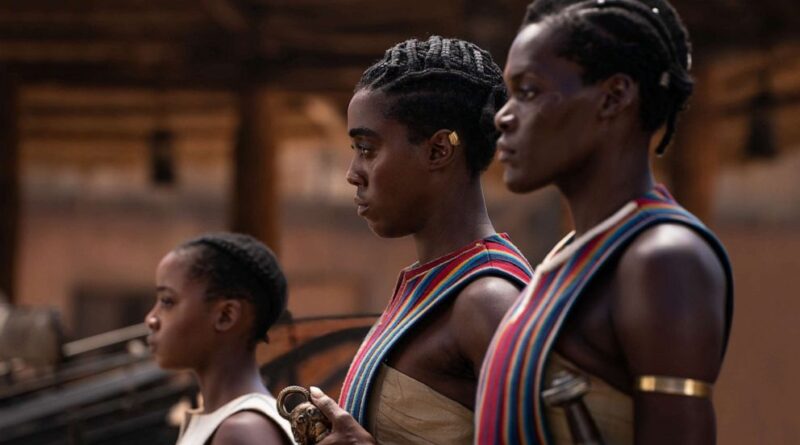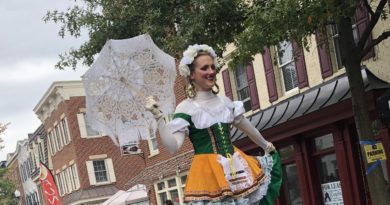The Woman King Review
Making sure we never forget why she was the first black woman to win an Oscar, an Emmy, and a Tony for her supreme acting, Viola Davis is featured in Gina Prince-Brythewood’s latest work: The Woman King. The film has a certain lushness about it, asserting Black women as pillars of power and strength, featuring beautifully depicted historical reenactments, and expressing sisterhood within African and Black communities.
The Use of Contrast
While the Woman King holds many amazing aspects, it is clear to any that watch that the plot is quite messy. There are several story lines within the movie that made it feel scattered. It’s disappointing because the film could’ve been just as if not more successful if it had focused on its three main plotlines. That being said, it’s impossible to deny that it’s expertly written. One noticeable feature is that the Woman King is the continuous use of contrast. While watching, it is noticeable that many scenes are subtly connected with others.
The difference between the Agojie helping each other, bouncing off of/using each other’s bodies in brutal battles vs. gently braiding each other’s hair and talking quietly about love and sacrifice.
Near the middle of the movie, King Ghezo, following advice from Nanisca, refuses to give anymore slaves to the Oyo tribe, and instead attempts to give them food and palm oil. The Oyo tribe’s leader, Oba Ade, refuses and instead tells the King that he will have 20 chosen Agojie instead. Nanisca somberly chooses 20 of her warriors, including Nawi, and they travel to the coast to be given to the Oyo.
However, when they arrive and stand before Oba, Nanisca says he will be given no tribute, and the Agojie run. Nanisca goes off plan and stays behind to fight Oba, as she had recognized him as one of the men who tainted her past. Nawi sees Nanisca fighting alone, and Oba’s tribemates rushing forward to assist him. Instead of leaving, Nawi takes her machete and cuts the rope holding open the metal gate, so that Nanisca’s fight is uninterrupted.
At this point in time, Nawi is still a relatively new recruit, and is unable to assist Nanisca in any other way. The two eventually escape together. Much later in the film, back in the coastal slave-trading town, Nanisca finds herself in battle with Oba Ade once again. Through great effort, she manages to take his life, but not without gravely injuring herself in the process. Two soldiers approach her, but are immediately caught in a scuffle with the now fully trained Nawi. Nawi sees that Nanisca cannot fight, and so she valiantly defends her, cutting down all who dare to approach. It was noticeable how before Nawi could only lookout for Nanisca, but now she could skillfully protect the general.
When Oba Ade arrives at the palace to collect the Oyo tribe’s tribute, Nanisca freezes. It is not his face that she recognizes first, but rather the earring in his left ear, which appears to be a horn or tusk. Later, she recounts to Amenaza, her closest friend, an event that happened many years ago. Nanisca had been captured and made a slave by the Oyo tribe. She says she was raped many times every night, and the scene shows a beaten Nanisca, crying and screaming, with none other than Oba above her, his hand paced domineeringly on her throat. The scene is blurred at the edges, voices heard faintly, and the music is quieted to a solemn tone. It truly depicts the powerlessness and distress of rape. The fight Nanisca has with Oba near the end of the movie is quite interesting. This is the first time we see her really struggle in combat, and one can imagine it’s due to what she’s going through mentally. Two symbolic moments are present. The first being when Nanisca rips the earring, the object that had helped her recognize Oba, from his earlobe. The second being when Oba manages to back Nanisca against a wall, choking her. She takes the small dagger he had pierced through her wrist, and stabs it into his stomach, killing him for the mere thought that he could over-power her once again.
The last great use of contrast comes when King Gbezo gathers all of his many wives, and Nanisca, to decide who he will choose as the Woman King. When the King chooses Nanisca, his favorite wife, Tara, is startled and angered. Throughout the movie, Tara openly expresses her dislike and jealousy towards Nanisca. She tells the other wives “She comes to him dirty and smelling of blood, yet he sees her anyway.” about Nanisca. It is made clear that Tara only cares about having power, and all of King Ghezo’s attention, yet she is not very knowledgeable on war or what it really takes to run a kingdom. When Nanisca leaves on a mission to attack the coastal european town, against King Ghezo’s wishes, with the celebration of the Woman King only an hour away, Tara all too eagerly offers to stand as the Woman King in Nanisca’s place. As the ceremony begins, Nanisca and the other Agojie return from the coastal town. It was amazing symbolism to see the difference in the two Woman King candidates: Tara, perfumed, bathed, and dressed delicately in gold and shells. Nanisca, covered in blood and offering King Ghezo the dead enemy’s sword.
The Beauty
Among the many note-worthy segments in this film, two scenes in particular are much more striking than the rest. The first being when Nawi first steps into the palace of women. Izogie places her hand on the entrance doors and tells Nawi “No men are allowed past this point.” She opens it and immediately the audience is hit with a radiant moving picture. Although many may argue that it was just women existing; some were doing laundry, others trained, there were groups of women scattered around, laughing, sewing beads, eating fruit,and doing each other’s hair, it was more than that. It was peaceful, harmonious. The very picture of Black/African excellence and sisterhood. Nawi had just come from an outside world where as a woman she was always below, expected to comply, and find a husband to submit to. Now she was welcomed into a community of seeking inner strength and just existing within the delightfulness of Black love.
The other segment is actually an after-scene following the end credits. Amenza goes to what appears to be a small burial site within the palace. She performs a farewell ritual for her fallen sisters. The screen slowly fades to black as she says goodbye, calling out their names. There is silence, and the last name that is spoken into the darkness is “Breonna”. While there has been no outward confirmation that this was a callout to BLM and Breonna Taylor, due to Gina Prince-Bythewood’s external support and advocacy for Black movements, and the fact that “Breonna” is not an African name that would’ve been featured, it is quite obvious why this was put in the end credits. A popular saying within the BLM movement is “Say Their Name”, say the name of those treated unfairly, say the names of those killed by injustice. Gina Prince-Bythewood weaved this callout perfectly into the end scene. However, many critics have come forward to say that this just adds to the fact that the entirety of the Woman King is BLM ‘propaganda’, and that the apparent inner message that “Men are evil” is a so-called ‘dangerous idea’ presented by the film.
Me, Personally
History aside, I am in love with this movie. The depictions of Black women strength and the beauty of my roots had me leaving the theater with a swell of pride blooming in my chest. I can’t wait until I’m able to stream it so I can watch it over again, and it is definitely a movie I recommend. Check out this article to see how other Bengals feel about it.



